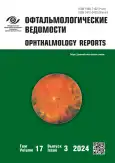Перемещение орбитальных жировых пакетов при нейротрофической кератопатии: серия клинических случаев
- Авторы: Потемкин В.В.1,2, Прокопчук В.С.1, Астахов С.Ю.1, Аникина Л.К.1,2, Петухов В.П.2, Варганова Т.С.2
-
Учреждения:
- Первый Санкт-Петербургский государственный медицинский университет им. акад. И.П. Павлова
- Городская многопрофильная больница № 2
- Выпуск: Том 17, № 3 (2024)
- Страницы: 69-78
- Раздел: Клинические случаи
- URL: https://ogarev-online.ru/ov/article/view/266775
- DOI: https://doi.org/10.17816/OV626379
- ID: 266775
Цитировать
Аннотация
Нейротрофическая кератопатия — заболевание, обусловленное нарушением иннервации роговицы, ведущее к возникновению и персистенции язвенных дефектов. К патогенетическим методам лечения относят невротизацию роговицы, которая технически трудновыполнима и сопряжена с длительным реабилитационным периодом, а также применение рекомбинантного человеческого фактора роста нервов (ценегермин), который практически недоступен ввиду высокой стоимости и отсутствия регистрации в Российской Федерации. Нами предложена методика сублимбального перемещения жировых пакетов орбитальной клетчатки. В основе метода лежат данные о смешанном происхождении орбитальной жировой клетчатки, обилии в ней нейротрофических факторов и стволовых клеток. Прооперировано 3 пациента с нейротрофической кератопатией, достигших конечной точки наблюдения через 2 мес. после вмешательства. Все предварительно получали терапию в течение 1–2 мес. без значимой динамики. Острота зрения составляла от 0,005 до 0,01. Проведено оперативное лечение в объёме сублимбального перемещения жировых пакетов орбитальной клетчатки, заключающееся в перемещении медиального и центрального орбитальных жировых пакетов в сформированный склеро-роговичный карман. В послеоперационном периоде у всех пациентов наблюдалась частичная эпителизация язвенного дефекта в течение первой недели с дальнейшим полным заживлением и формированием рубца. Полученная максимальная острота зрения в срок 2 мес. после проведённой операции составляла от 0,06 до 0,3.
Полный текст
Открыть статью на сайте журналаОб авторах
Виталий Витальевич Потемкин
Первый Санкт-Петербургский государственный медицинский университет им. акад. И.П. Павлова; Городская многопрофильная больница № 2
Email: potem@inbox.ru
ORCID iD: 0000-0001-7807-9036
SPIN-код: 3132-9163
канд. мед. наук
Россия, Санкт-Петербург; Санкт-ПетербургВера Сергеевна Прокопчук
Первый Санкт-Петербургский государственный медицинский университет им. акад. И.П. Павлова
Автор, ответственный за переписку.
Email: prokopchuk.vera98@gmail.com
ORCID iD: 0000-0003-3310-6234
SPIN-код: 3654-9049
MD
Россия, Санкт-ПетербургСергей Юрьевич Астахов
Первый Санкт-Петербургский государственный медицинский университет им. акад. И.П. Павлова
Email: astakhov73@mail.ru
ORCID iD: 0000-0003-0777-4861
SPIN-код: 7732-1150
д-р мед. наук, профессор
Россия, Санкт-ПетербургЛилия Камилевна Аникина
Первый Санкт-Петербургский государственный медицинский университет им. акад. И.П. Павлова; Городская многопрофильная больница № 2
Email: lily-sai@yandex.ru
ORCID iD: 0000-0001-8794-0457
SPIN-код: 3359-4587
Россия, Санкт-Петербург; Санкт-Петербург
Владимир Павлович Петухов
Городская многопрофильная больница № 2
Email: v.p.petukhov@gmail.com
ORCID iD: 0000-0003-4973-3937
SPIN-код: 2879-9313
MD
Россия, Санкт-ПетербургТатьяна Сергеевна Варганова
Городская многопрофильная больница № 2
Email: varganova.ts@yandex.ru
ORCID iD: 0009-0000-4342-5998
канд. мед. наук
Россия, Санкт-ПетербургСписок литературы
- Dua H.S., Said D.G., Messmer E.M., et al. Neurotrophic keratopathy // Prog Retin Eye Res. 2018. Vol. 66. P. 107–131. doi: 10.1016/j.preteyeres.2018.04.003
- Каспарова Е.А., Марченко Н.Р. Нейротрофический кератит. Этиология, патогенез, клинические проявления. Обзор литературы. Часть 1 // Офтальмология. 2022. Т. 19, № 1. С. 38–45. EDN: MMMNAW doi: 10.18008/1816-5095-2022-1-38-45
- Yavuz Saricay L., Bayraktutar B.N., Lilley J., et al. Efficacy of recombinant human nerve growth factor in stage 1 neurotrophic keratopathy // Ophthalmology. 2022. Vol. 129, N 12. P. 1448–1450. doi: 10.1016/j.ophtha.2022.08.014
- NaPier E., Camacho M., McDevitt T.F., Sweeney A.R. Neurotrophic keratopathy: current challenges and future prospects // Ann Med. 2022. Vol. 54, N 1. P. 666–673. doi: 10.1080/07853890.2022.2045035
- Roumeau S., Dutheil F., Sapin V., et al. Efficacy of treatments for neurotrophic keratopathy: a systematic review and meta-analysis // Graefes Arch Clin Exp Ophthalmol. 2022. Vol. 260, N 8. P. 2623–2637. doi: 10.1007/s00417-022-05602-z
- NaPier E., Camacho M., McDevitt T.F., Sweeney A.R. Neurotrophic keratopathy: current challenges and future prospects // Ann Med. 2022. Vol. 54, N 1. P. 666–673. doi: 10.1080/07853890.2022.2045035
- Lin K.J., Loi M.X., Lien G.S., et al. Topical administration of orbital fat-derived stem cells promotes corneal tissue regeneration // Stem Cell Res Ther. 2013. Vol. 4, N 3. P. 72. doi: 10.1186/scrt223
- Tawfik H.A., Dutton J.J. Embryologic and fetal development of the human orbit // Ophthalmic Plast Reconstr Surg. 2018. Vol. 34, N 5. P. 405–421. doi: 10.1097/IOP.0000000000001172
- Ho J.H., Ma W.H., Tseng T.C., et al. Isolation and characterization of multi-potent stem cells from human orbital fat tissues // Tissue Eng Part A. 2011. Vol. 17, N 1–2. P. 255–266. doi: 10.1089/ten.TEA.2010.0106
- Патент Республики Беларусь на изобретение № 14927. Опубл. 30.10.2011. Позняк Н.И., Беляковский П.В., Ковшель Н.М., и др. Способ хирургического лечения дистрофических заболеваний сетчатки и зрительного нерва. Режим доступа: https://bypatents.com/patents/poznyak-nikolajj-ivanovich Дата обращения: 03.04.2024
- Holan V., Palacka K., Hermankova B. Mesenchymal stem cell-based therapy for retinal degenerative diseases: experimental models and clinical trials // Cells. 2021. Vol. 10, No. 3. P. 588. doi: 10.3390/cells10030588
- Беляковский П.В., Позняк Н.И. Нейропротекторное влияние эмбриональных стволовых клеток при токсическом поражении зрительного нерва каиновой кислотой // Офтальмология в Беларуси. 2010. № 3. С. 37–42. EDN: ONNVQR
- Беляковский П.В., Позняк Н.И., Позняк С.Н., Ковшель Н.М. Терапевтический потенциал мезенхимальных стволовых клеток в лечении дегенеративных изменений заднего отрезка глаза // ARS mediсa. Искусство медицины. 2012. № 14. С. 190–194.
- Эзугбая М.И., Рикс И.А., Астахов С.Ю., и др. Клинико-иммунологические аспекты нейротрофической кератопатии // Medline.ru. 2022. Т. 23, № 1. С. 119–135. EDN SKGBMM
Дополнительные файлы


























